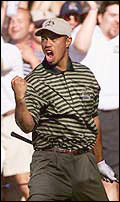2001 Masters Tournament

A historical companion to the Masters Tournament
 Tiger Woods poised to become the first reigning champion of all four major golf tournaments. Tournament Records
Related Links |
The first of the Professional Golf Association Tour's four major tournaments held annually (U.S. Open, British Open, and PGA Championship are the others), the Masters Tournament brings together the world's best golfers, making it the golf equivalent of baseball's All-Star Game and opening day wrapped into one.
Editor's Note: The 2001 masters was held April 5-8. Winning an unprecedented fourth consecutive professional major title, Tiger Woods captured the 2001 Masters Tournament with a 16-under-par total 272. This article was written before the tournament, and is retained for histoorical reference.
This year's 65th edition of the Masters Tournament could be historic. The incomparable Tiger Woods finished fifth in last year's Masters Tournament but bounced back to win the final three major tournaments in 2000. He is favored to win this year's Masters and in doing so could become the first golfer to be reigning champion of all four majors simultaneously.
Woods, 25, already owns one Masters Tournament title. He won the 1997 Masters Tournament in record-setting fashion, tying or breaking 26 tournament records.
Ben Hogan is the only other golfer to win three majors in one year (1953). And the only golfer to win four in a calendar year was Bobby Jones, who in 1930 won the U.S. and British Open as well as the U.S. Amateur and British Amateur tournaments, which have since lost their "major" status.
Jones retired from golf that year and at 28 had already established himself as one of the sport's greatest players. He next project was to create the tournament that would become the Masters.
Course History
Augusta National Golf Club in Augusta, Ga. has hosted every Masters Tournament. The course was built on a 365-acre plot of land that was a late 19th century commercial plant nursery, specializing in imported plants and trees. The course was designed by Jones and a Scottish doctor named Alister Mackenzie. The design borrows heavily from the old courses in his native Scotland and still incorporates many of the nursery's prized flora.
Tournament History
Course co-designer Jones and Clifford Roberts, a New York investment banker, founded the club and created the Masters Tournament in 1934. They envisioned a place and event that would gather the great golfers of the day. Originally called the Augusta National Invitation Tournament, Jones agreed to change the name of the tournament to "the Masters" in 1939—a name he originally thought was too presumptuous. Today there are 17 specific requirements golfers must meet to earn an invitation to the Masters.
Augusta National Landmarks and Flora Facts
Amen Corner—Nickname given to holes 11, 12, and 13 by Sports Illustrated writer Herbert Warren Wind. Wind used the nickname to describe Arnold Palmer's clutch performance during that stretch of holes en route to winning the 1958 tournament. It was borrowed from a jazz recording called "Shouting at Amen Corner."
Green Jackets—Club members were encouraged to wear green blazers starting in 1937 so that patrons would know to whom they should ask questions. The winner of each Masters tournament, starting with Sam Snead in 1949, has been awarded one of these single-breasted green jackets. Traditionally, the reigning champion owns the jacket for one year and then returns it to the club where it is stored and is made available whenever the champion visits.
Hole Names—From the Asian Tea Olive at the 1st hole to the American Holly at the 18th, each of the course's 18 holes is named after a specific plant, flower, or tree found on the club's grounds.
Magnolia Lane—This 250-yard-long path from the entrance gate to the clubhouse is lined with 61 giant Magnolia trees planted a decade before the Civil War.
Eisenhower Tree—A frequent hacker and club member since 1948, former President Dwight Eisenhower hit this 65-foot-high loblolly pine on the 17th hole so often that in 1956 he proposed it be cut down. His attempts were thwarted by the club's governing board, but the tree has been associated with him ever since.







